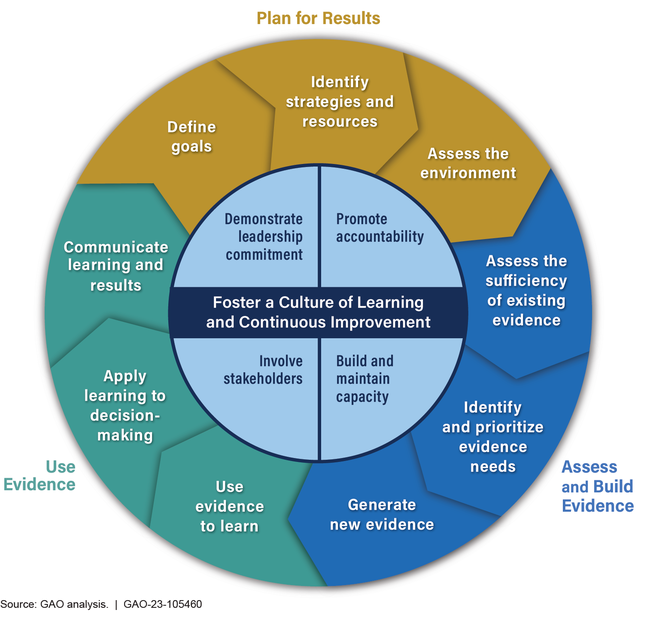Evidence-Based Policymaking: Practices to Help Manage and Assess the Results of Federal Efforts
Fast Facts
Federal decision makers need evidence—such as data and the results of studies—to determine if programs are working as intended and to identify potential improvements.
Our past work has found mixed progress across government in collecting, analyzing, and using evidence effectively to make decisions. In this guide, we identify key practices that could help agencies:
Plan for results
Assess and build evidence
Use evidence
Foster a culture of learning and continuous improvement
The guide provides further details including key actions for implementing the practices and related illustrative examples from some of our recent audit reports.

Highlights
Key Takeaways
GAO developed 13 key practices that can help federal leaders and employees develop and use evidence to effectively manage and assess the results of federal efforts. The key practices are distilled from hundreds of actions identified in GAO’s past work as effective for implementing federal evidence-building and performance-management activities.
Since 1990, a series of federal laws and executive actions have established requirements for agencies to build and use different types of evidence to understand and improve results. Evidence can include performance information, program evaluations, statistical data, and other research and analysis.
As illustrated below, the 13 key practices GAO developed can be viewed as four interrelated topic areas: (1) plan for results, (2) assess and build evidence, (3) use evidence, and (4) foster a culture of learning and continuous improvement.
Practices to Help Effectively Implement Federal Evidence-Building and Performance-Management Activities

Why This Matters
Federal decision makers need evidence about whether federal programs and activities are achieving intended results. Congressional and executive branch leaders can use evidence to better understand and address challenges, and set priorities to help improve implementation and performance.
However, GAO’s past work has found that the federal government has made mixed progress in (1) developing relevant, high-quality evidence, (2) using it in decision-making, and (3) ensuring sufficient capacity to undertake those activities.
The Foundations for Evidence-Based Policymaking Act of 2018 includes a provision for GAO to identify actions to improve federal agency capacity to build and use evidence.
This product develops key practices and highlights related federal agency examples that GAO's past work has identified for implementing evidence-building and performance-management activities.
How to Use This Guide
This guide can help executive branch leaders and employees at any organizational level—such as an individual project or program, component agency or office, department, or cross-agency effort—build and use evidence to manage the organization’s performance. In addition, it can help inform Congress’s oversight of the Executive Branch’s evidence-building and performance-management activities, including implementation of relevant legal requirements.
This guide provides a primer on federal evidence-building and performance-management activities. It also provides further details about the 13 key practices, including key actions to implement the practices and related examples illustrating implementation by one or more agencies.
How GAO Did This Study
To develop the 13 key practices, GAO reviewed (1) federal laws and guidance related to evidence-building and performance-management activities and (2) its related past reports since 1996. In 1996, GAO developed a guide that identified key practices for federal organizational performance management. Since that time, GAO has issued approximately 200 reports that updated and expanded those 1996 practices, or identified new ones to reflect changes in federal laws and guidance and a broader range of evidence-building activities. GAO identified and distilled several hundred relevant actions into the 13 practices. GAO refined the practices and actions, as appropriate, based on input from cognizant officials at 24 major federal agencies and Office of Management and Budget staff.
To help illustrate each practice, GAO reviewed its recent reports—from fiscal years 2022 or 2023—to identify related recent examples. GAO selected illustrative examples where it found agencies had effectively implemented the practice. GAO also ensured that the selected examples covered (1) a range of agencies and different policy and management areas, and (2) different organizational levels, from individual programs to interagency efforts.
Additionally, GAO analyzed results from a survey it administered from July to December 2020 to assess the association between certain practices and increased use of evidence in decision making. The survey covered a stratified random sample of about 4,000 managers at 24 major federal agencies. The survey had a 56 percent response rate. Results can be generalized to the population of managers government-wide and at each agency.
In response to a draft of this report, the U.S. Agency for International Development provided written comments that highlighted results from GAO’s survey and the agency’s program evaluation practices. The Office of Management and Budget and remaining 23 agencies did not provide comments.
For more information, contact Dawn Locke at (202) 512-6806 or locked@gao.gov, or Jamila Kennedy at (202) 512-3637 or kennedyjj@gao.gov.
